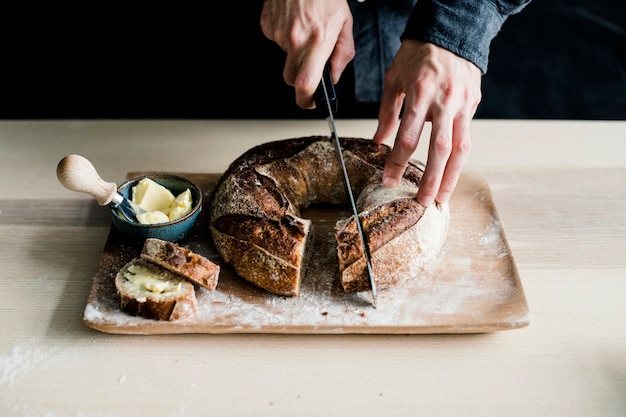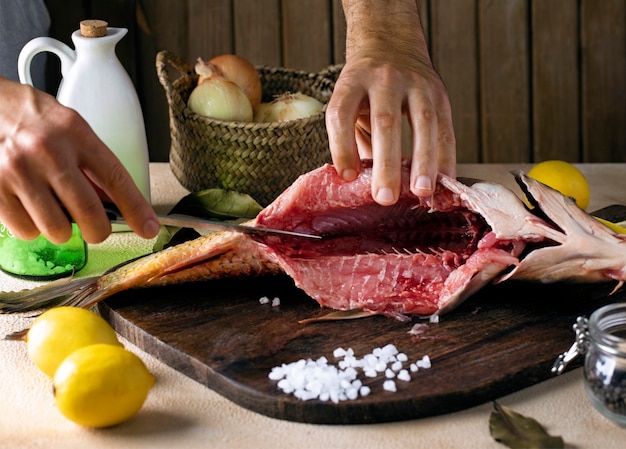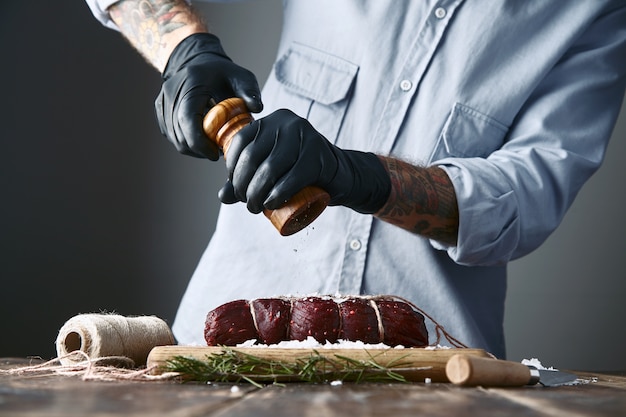Ah, steak. That glorious, juicy, tender hunk of heaven that makes every meal feel like a special occasion. But for many of us, the journey to a perfectly cooked steak has been filled with burnt edges and disappointing dryness.
Don't worry, you're not alone! I've been there too, fumbling through countless attempts before finally mastering the art of the medium-rare steak. This guide is my love letter to all those who've been intimidated by the seemingly complicated world of steak cooking.
We'll break it down step by step, from choosing the right cut to achieving that coveted medium-rare finish, with insider tips, tricks, and a sprinkle of my own steak-loving wisdom. Let's get started, shall we?
(Part 1) Choosing Your Steak: The Foundation of Flavor

The Cut: Your Steak's Personality
Just like choosing the right ingredient for a recipe, picking the perfect cut of beef is vital for your steak's success. Each cut brings a unique flavor and texture to the table, like individual personalities. Here are a few of my favorites for achieving that juicy medium-rare:
- Rib-eye: Oh, rib-eye, my heart belongs to you. This cut is known for its rich, buttery flavor and gorgeous marbling, making it a true champion of tender and delicious. Perfect for grilling or pan-frying, it’s a classic for a reason.
- new york strip: The New York Strip offers a beautifully balanced flavor profile – it’s leaner than a rib-eye but still boasts a wonderful tenderness. It’s another excellent choice for grilling or pan-frying.
- Sirloin: This is a leaner option with a bit more chew to it. A great choice for grilling or pan-frying, it's versatile and perfect for those who prefer a less fatty steak.
- filet mignon: The most tender cut of beef, filet mignon is a real treat. It's expensive, but oh-so-worth it for special occasions. The delicate texture makes it perfect for cooking on the stovetop or in the oven.
Thickness: The Key to Even Cooking
Think of your steak’s thickness like a roadmap for heat distribution. A thicker cut is more forgiving and can handle a longer cooking time, allowing for a more even cook. I usually opt for steaks at least 1 inch thick, ensuring a juicy and flavorful finish.
Marbling: The Secret Ingredient
Marbling, those beautiful white streaks of fat running through the meat, isn’t just a pretty sight. It’s a key ingredient in creating a juicy, flavorful steak. The fat melts during cooking, adding richness and tenderness to every bite. Look for cuts with good marbling – you won’t regret it!
(Part 2) Prepping Your Steak: The Art of Preparation

The Right Start for a Delicious Finish
Now that you’ve chosen your perfect cut, let’s get it ready for the heat.
- Pat it Dry: Using paper towels, gently pat your steak dry. This helps achieve a crisp, flavorful sear and prevents steam from forming during cooking, which can make your steak soggy and dull the taste.
- Season Liberally: Salt and pepper are the foundation of a great steak. I use a simple combination of coarse sea salt and freshly ground black pepper. Don't be afraid to use a generous amount! You can also experiment with other spices and herbs, creating your own unique flavor combinations.
- Room Temperature, Please: If you have time, take your steak out of the fridge about 30 minutes before cooking. This allows the steak to cook more evenly, ensuring a juicy center. But if you forget, don't worry, it's not a dealbreaker!
The Importance of Resting: A Moment for the Juices to Redistribute
Resting is a crucial step that many beginners overlook. It allows the juices to redistribute throughout the steak, preventing them from running out when you cut into it, making for a juicier, more flavorful final product.
- Cover and Relax: After cooking, cover your steak loosely with foil and let it rest for 5-10 minutes before slicing and serving. This is crucial for achieving that perfectly tender and juicy steak.
(Part 3) cooking techniques: Unveiling the Best Methods

Pan-Frying: Quick and Easy, with Crispy Results
Pan-frying is my go-to technique for a quick and delicious steak. It delivers a beautiful, crispy sear and a juicy interior, perfect for a weeknight dinner.
- Hot Pan, Happy Steak: Use a heavy-bottomed skillet and heat it over medium-high heat. You want the pan to be hot enough to sizzle when you add the steak.
- Oiling Up: Use a high-heat oil like avocado oil or grapeseed oil. Avoid olive oil, as it has a lower smoke point and can burn before the steak is cooked.
- Sear and Sizzle: Place your steak in the hot pan and cook for 2-3 minutes per side for medium-rare. Use tongs to flip the steak to ensure an even cook.
- Slow Down the Heat: Once you've achieved that beautiful sear, reduce the heat to medium-low and continue cooking for another 2-3 minutes per side to cook the steak through.
- Rest, Relax, Enjoy: Remove the steak from the pan and let it rest for 5-10 minutes before slicing and serving.
Grilling: Outdoor Flavor and Smoky Delights
Grilling is another excellent method for achieving that smoky flavor and iconic grill marks.
- Prep and Preheat: Clean your grill and preheat it to medium-high heat.
- Oiled Grates, Happy Steaks: Use a grill brush to lightly oil the grates. This prevents the steak from sticking.
- Sear It On: Place your steak on the grill and cook for 2-3 minutes per side for medium-rare.
- Adjust for Even Cooking: Once you’ve achieved a good sear, move the steak to a cooler part of the grill or close the lid to continue cooking the steak through without burning it.
- Rest and Enjoy: Remove the steak from the grill and let it rest for 5-10 minutes before slicing and serving.
(Part 4) Mastering the Medium-Rare: The Perfect Level of Doneness
Understanding Doneness: The Journey to Perfection
The key to a perfect medium-rare steak is knowing how to gauge doneness. There are two reliable methods to achieve this:
- The Finger Test: This old-school technique involves pressing your finger against your palm to feel the firmness of the fleshy part below your thumb. This is how a rare steak should feel. Then, press your index finger against your palm. That's the feeling you're aiming for with a medium-rare steak.
- The meat thermometer: This is the most accurate way to determine doneness. Insert the thermometer into the thickest part of the steak and aim for an internal temperature of 130-135 degrees Fahrenheit for medium-rare.
Avoiding the Overcook Disaster: A Steak's Worst Enemy
The most common mistake beginners make is overcooking their steak. Remember, the steak continues to cook even after you remove it from the heat.
- Trust the Thermometer: Don’t rely solely on the finger test, especially if you're new to cooking steak. Use a meat thermometer for a more accurate reading.
- Watch the Clock: A few extra seconds can make a big difference, so be sure to watch the clock closely.
- Take it Off Early: If you're unsure, it's better to remove the steak from the heat a little early than to overcook it. You can always add a few more seconds if it needs a bit more cooking.
(Part 5) Serving the perfect steak: A Symphony of Flavor
Keeping it Simple: The Beauty of Simplicity
Once you’ve cooked your steak to perfection, it’s time to enjoy the fruits of your labor. There’s no need to overcomplicate things. I like to keep things simple and focus on the pure flavor of the steak.
- A Touch of Butter: I like to add a knob of butter to my steak right before serving. It melts over the steak, adding an extra layer of richness and flavor.
- Salt: A Finishing Touch: A sprinkle of sea salt on top enhances the natural flavors of the steak.
- Pepper: The Classic Companion: Freshly ground black pepper is a classic accompaniment to any steak, adding a touch of spice.
side dishes: Complementary Flavors
While I prefer to keep my steak simple, a good side dish can elevate the entire meal. Here are a few of my favorites:
- Roasted Vegetables: Roasted vegetables are a healthy and flavorful side dish that pairs perfectly with steak. They bring a delightful burst of color and texture to the plate.
- mashed potatoes: A classic comfort food, mashed potatoes complement the richness of the steak, creating a truly satisfying meal.
- Asparagus: A light and refreshing side dish, asparagus provides a nice contrast to the steak, adding a touch of green and a delicate flavor.
(Part 6) Troubleshooting: Navigating the Ups and Downs of Cooking Steak
Steak Sticking to the Pan: A Common Problem
This happens to the best of us, and it's usually due to not using enough oil or your pan not being hot enough.
- High-Heat Oil is Key: Use avocado oil or grapeseed oil, as they have a high smoke point and won’t burn before the steak is cooked.
- Let the Pan Heat Up: Make sure your pan is hot enough before adding the steak. You should hear a sizzle when you add it.
- Patience is a Virtue: Let the steak sear for a few minutes before flipping. This helps create a nice crust and prevents sticking.
Overcooked Steak: A Learnable Lesson
We’ve all been there. It happens, even to the most experienced cooks.
- Don't Panic: It's not the end of the world.
- Thin Slices for Tenderness: Slice the steak thin to make it more tender.
- Sauce to the Rescue: A flavorful sauce can help mask any dryness and add a burst of flavor.
Steak Not Browning Properly: A Matter of Heat
If your steak isn’t browning properly, it’s usually a sign that your pan isn’t hot enough.
- Use a Hot Enough Pan: As mentioned earlier, the pan needs to be hot enough to sizzle when you add the steak.
- Avoid Overcrowding: If you have too many steaks in the pan, it will cool down the temperature and prevent them from browning properly.
- Flip with Care: Flip your steak only once or twice. Over-flipping can prevent it from browning properly.
(Part 7) Common Mistakes: The Pitfalls to Avoid
Overcooking: A Steak's Biggest Enemy
Overcooking is the most common mistake, especially for beginners. It leads to a dry, tough steak that’s far from the juicy, tender experience we’re aiming for.
- Use a Meat Thermometer: This is the most accurate way to gauge doneness and prevent overcooking.
- Take it Off Early: It's better to err on the side of caution and remove the steak from the heat a little early. You can always cook it for a few more seconds if needed.
Not Seasoning Enough: The Foundation of Flavor
Salt and pepper are the building blocks of a great steak.
- Season Liberally: Don’t be shy with the salt and pepper.
- Season Both Sides: Make sure to season both sides of the steak to create an even flavor profile.
Not Resting the Steak: The Importance of Patience
Resting is crucial for allowing the juices to redistribute throughout the steak.
- Cover the Steak with Foil: This will help trap the heat and moisture.
- Let it Rest for 5-10 Minutes: Don’t rush it! Let the steak relax and allow the juices to redistribute.
(Part 8) Beyond the Basics: Exploring the World of Flavor
Experimenting with Flavor: Unleashing Your Creativity
Once you've mastered the basics, it’s time to get creative! There are countless ways to add flavor to your steak.
- Marinades: A marinade can add a burst of flavor and tenderize the steak.
- Rubs: A dry rub can add a layer of flavor and spice, creating a unique and delicious crust.
- Sauces: A delicious sauce can elevate your steak to the next level.
Steak for Every Occasion: Versatility is Key
Steak isn’t just for special occasions. It can be a quick and easy weeknight meal or the centerpiece of a lavish dinner party.
- Steak Sandwiches: A quick and easy meal, perfect for lunch or dinner.
- Steak Salads: A light and refreshing meal, great for warmer weather.
- Steak Tacos: A fun and festive meal, perfect for gatherings with friends and family.
(Part 9) FAQs: Answering Your Most Frequently Asked Questions
Q1: What's the best way to tell if a steak is cooked to medium-rare?
The best way to tell if a steak is cooked to medium-rare is to use a meat thermometer. Aim for an internal temperature of 130-135 degrees Fahrenheit. You can also use the finger test, but a meat thermometer is more accurate, especially for beginners.
Q2: How long should I cook a steak for medium-rare?
The cooking time for a steak will vary depending on the thickness of the steak and the cooking method you choose. A general rule of thumb is to cook a 1-inch thick steak for 2-3 minutes per side for medium-rare.
Q3: What if my steak is overcooked?
Don't panic! If your steak is overcooked, it's still edible. Slice it thin to make it more tender and add a flavorful sauce to mask any dryness.
Q4: What are some good side dishes for steak?
Roasted vegetables, mashed potatoes, asparagus, and salads are all excellent side dishes for steak.
Q5: Can I cook steak in the oven?
Yes, you can cook steak in the oven. Preheat your oven to 400 degrees Fahrenheit. Place the steak on a baking sheet and cook for 5-7 minutes per side for medium-rare.
(Part 10) Conclusion: Embrace the Journey to steak mastery
There you have it! You're now armed with the knowledge and confidence to conquer the world of steak cooking. Remember, the journey to steak mastery is all about experimentation, having fun, and enjoying the delicious results. Don't be afraid to try different cuts, cooking techniques, and seasonings. You never know, you might just discover your new favorite steak recipe!
So, go forth and create those perfect medium-rare masterpieces!
Everyone is watching

How to Cook Frozen Lobster Tails Perfectly: A Step-by-Step Guide
RecipesLobster. Just the word conjures up images of lavish meals, special occasions, and a taste of luxury. But let's...

Pork Fillet Cooking Time: How Long to Cook It Perfectly
RecipesPork fillet, or tenderloin as it's sometimes called, is a real favourite in our house. It's so versatile, and...

Pigs in a Blanket Cooking Time: How Long to Bake for Perfect Results
RecipesAh, pigs in a blanket. Just the name conjures up images of those delightful little parcels of crispy pastry en...

The Ultimate Guide to Cooking Delicious Frankfurters
RecipesLet's face it, we all love a good frankfurter. It's a classic, simple, and always satisfying. But let's be rea...

Wolf Meat Recipes: A Guide to Cooking Wild Game
RecipesLet's be honest, you don't see wolf meat at your local butcher shop every day. It's a bit of a wild card, but ...
